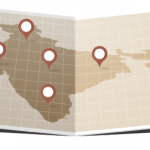If more cars are not the solution, I would think that perhaps better roads would work. With wide lanes and smoother pavement, crowding, chaos and death-defying lane switches would have to diminish. Why not build four-, eight- and even 12-lane expanses of asphalt and concrete—nicely demarcated by broken, single and double lines to show where the lanes are and strong metal guard rails to keep traffic going into town safely separated from traffic going out of town?
With the equivalent of our US 5, 85 or 95, highway order would be possible and the toll of death and musculoskeletal injury should fall.
If only life were so simple.
India does have some new highways, but they are far away from the solution of some deep and exasperating problems. The Yamuna Highway is such an example. This modern six-lane highway goes between Delhi and Agra, the site of the Taj Mahal and home of a shoe industry started by the former Untouchables.
The Yamuna Highway is designed to cut travel time in half, but it has its restrictions. As the website says, push carts and bullock carts are not allowed. Further, as a toll road, the cost is high—prohibitively so for most travelers—and there are few entrances and exits. As a result, the road is quite empty, or at least it was on the day I did the trip. Boredom sets in quickly, especially for those accustomed to the energizing chaos of the regular roads which demand constant awareness of all senses. Alas, drivers fall asleep on the open highway and crash.
The modern road has other hazards. Without the crowding of the regular roads and the traffic slowing from the meandering cows, cars can speed. In the summer when the temperature in that part of the world reaches 45–50º C, the road is frying pan hot. Friction from tires spinning on the concrete adds its heat to expand the air in the tires. Pressure rises ominously, and tires explode causing terrible high-speed wrecks. Tires of the NASCAR kind could probably survive this environmental assault, but such tires are very, very expensive, like $350 to $450 for each tire, and they only last about 60 laps, which is more or less the distance from Agra to Delhi.
A road sign read, “Over speed will invite prosecution,” but it should say, “Over speed will invite catastrophe,” but the cars whiz along.
The modern highways seem to have other problems that add to the woes. To keep out those who can’t afford the toll, the Yamuna highway is surrounded by barbed wire fences a few feet high. Barbed wire, however, may not suffice, because I saw three men lifting a motor bike over the fence, no doubt to avoid the toll and drive some distance before repeating the process somewhere down the road to get off the road.
